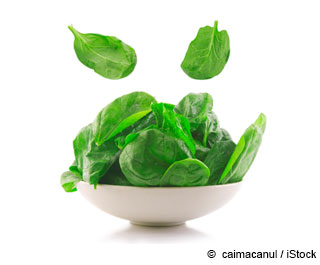The Scoop on Spinach
Botanical name: Spinacia oleracea

Obscurely referred to for years as "the Spanish vegetable" in England, the name of this leafy green was later shortened to what we call it today.1 Spinach cultivation is thought to have originated from ancient Persia, later spreading to Nepal, and by the seventh century, to China, where it’s still called "Persian Greens." The Moors introduced it to Spain around the 11th century.2
According to the United States Department of Agriculture (USDA), Americans consume nearly 2 1/2 pounds of spinach per year, per capita. This easily quadruples the amount eaten 40 years ago,3 possibly because of a drastic overhaul in image and presentation.
Now greener, tastier and crisper by freezing, fresh spinach is often used for salads and in place of lettuce on sandwiches.
No other vegetable has ever gained the fame that spinach did in the 193 0s through the cartoon character Popeye.4 Parents often encouraged their children to eat their spinach so they would grow up to be big and strong like the cartoon sailor, and there’s actually some truth to this claim.
Health Benefits of Spinach
Vitamin K, A and C, as well as folate, manganese, magnesium, iron, potassium and calcium. It’s also a good source of niacin, zinc, protein, fiber, vitamin E , thiamin, vitamin B6, phosphorus and copper . In other words, it’s loaded with good things for every part of your body5 to help keep cholesterol from oxidizing and protect your body from free radicals,6,7 particularly in the colon.8 The folate also good for maintaining a healthy cardiovascular system,9 while its magnesium content helps lower high blood pressure levels.10
Studies have also shown that spinach helps maintain vigorous brain function, memory and mental clarity.11
In order to retain the rich iron content of spinach while cooking, add a bit of lemon juice or vinegar into your dish.12
Studies Done on Spinach
Because of the potentially high incidence of Dichlorodiphenyltri chloroethane (DDT) contamination, be sure to buy only organic varieties of spinach as much as possible. A known cause of cancer, birth defects and reproductive damage,13 DDT has been banned in the U.S. since 1972,14 but it may still be manufactured and exported to other countries, where it’s most often used to fight mosquito-borne malaria.15
What’s worse, DDT can stay in soil for years. In fact, spinaches grown in the soils that have been sprayed with DDT before 1972 are this pesticide, according to a report by the USDA. 16,17
Spinach Nutrition Facts
Serving Size: 3.5 ounces (100 grams), raw
| Calories |
23 |
|
| Calories from Fat |
3 |
|
| Total Fat |
0 g |
1% |
| Saturated Fat |
0 g |
0% |
| Trans Fat |
|
|
| Cholesterol |
0 mg |
0% |
| Sodium |
79 mg |
3% |
| Total Carbohydrates |
4 g |
1% |
| Dietary Fiber |
2 g |
9% |
| Sugar |
0 g |
|
| Protein |
3 g |
|
| Calcium 10% |
Iron |
15% |
*Percent Daily Values are based on a 2,000 calorie diet. Your daily values may be higher or lower depending on your calorie needs.
Spinach Healthy Recipes:
Creamed Spinach

|
Ingredients:
|
|
✓ 3/4 cup raw whole milk
|
✓ 1/4 cup water
|
✓ 2 medium garlic cloves, minced
|
|
✓ 1 tablespoon raw grass fed butter
|
✓ 1 1/2 tablespoons arrowroot
|
✓ 2 pounds spinach or chard, steamed and drained
|
|
✓ 1/4 cup Parmesan cheese, grated
|
✓ 1/4 teaspoon nutmeg, ground
|
✓ Sea salt and freshly ground pepper, to taste
|
Procedure:
- In a medium saucepan, combine milk, water and garlic. Heat slowly until very hot and steamy. Let the mixture stand, covered, for five to 10 minutes. This allows the garlic to soften.
- Melt the butter in another medium saucepan over medium-the arrowroot, and then add the hot milk mixture, whisking until smooth. Stir in the spinach or chard, and cook until the sauce is thick and bubbly and the spinach is tender but still green, about six minutes.
- Stir in the cheese and season with nutmeg, salt and pepper. Serve immediately.
This recipe makes four servings.
(Recipe adapted from “Healthy Recipes for Your Nutritional Type” by Dr. Mercola)
Spinach Fun Facts
Known to thrive better in cooler climates, Arab farmers were nevertheless able to successfully cultivate spinach in the warmer18
Summary
Low in calories but packed with nutrients, spinach is one of the many leafy vegetables becoming more and more prevalent on the salad bar. Its versatility makes it easily adaptable in healthy vegetable drinks and smoothies, lightly sautéed as a stand-alone side dish, and added to soups or stir.